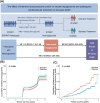Effects of Intensive Systolic Blood Pressure Control on Glycometabolic and Cardiovascular Outcomes in Normoglycemic Patients: A Secondary Analysis of a Randomized Trial
- PMID: 40337145
- PMCID: PMC12056500
- DOI: 10.1002/mco2.70197
Effects of Intensive Systolic Blood Pressure Control on Glycometabolic and Cardiovascular Outcomes in Normoglycemic Patients: A Secondary Analysis of a Randomized Trial
Conflict of interest statement
The authors declare no conflicts of interest.
Figures

Similar articles
-
Assessment of Risk of Harm Associated With Intensive Blood Pressure Management Among Patients With Hypertension Who Smoke: A Secondary Analysis of the Systolic Blood Pressure Intervention Trial.JAMA Netw Open. 2019 Mar 1;2(3):e190005. doi: 10.1001/jamanetworkopen.2019.0005. JAMA Netw Open. 2019. PMID: 30848803 Free PMC article. Clinical Trial.
-
Longer-Term All-Cause and Cardiovascular Mortality With Intensive Blood Pressure Control: A Secondary Analysis of a Randomized Clinical Trial.JAMA Cardiol. 2022 Nov 1;7(11):1138-1146. doi: 10.1001/jamacardio.2022.3345. JAMA Cardiol. 2022. PMID: 36223105 Free PMC article.
-
Intensive systolic blood pressure control and incident chronic kidney disease in people with and without diabetes mellitus: secondary analyses of two randomised controlled trials.Lancet Diabetes Endocrinol. 2018 Jul;6(7):555-563. doi: 10.1016/S2213-8587(18)30099-8. Epub 2018 Apr 21. Lancet Diabetes Endocrinol. 2018. PMID: 29685860 Free PMC article.
-
Outcomes of Intensive Systolic Blood Pressure Reduction in Patients With Intracerebral Hemorrhage and Excessively High Initial Systolic Blood Pressure: Post Hoc Analysis of a Randomized Clinical Trial.JAMA Neurol. 2020 Nov 1;77(11):1355-1365. doi: 10.1001/jamaneurol.2020.3075. JAMA Neurol. 2020. PMID: 32897310 Free PMC article. Review.
-
Pros and Cons of Intensive Systolic Blood Pressure Lowering.Curr Hypertens Rep. 2018 Mar 6;20(2):16. doi: 10.1007/s11906-018-0806-x. Curr Hypertens Rep. 2018. PMID: 29511979 Review.
References
-
- Lauder L., Mahfoud F., Azizi M., et al., “Hypertension Management in Patients With Cardiovascular Comorbidities,” European Heart Journal 44, no. 23 (2023): 2066–2077. - PubMed
-
- Yang R., Zhu Y., Xu M., Tao Y., Cong W., and Cai J., “Intensive Blood Pressure Lowering and the Risk of New‐Onset Diabetes in Patients with Hypertension: A Post‐Hoc Analysis of the STEP Randomized Trial,” European Journal of Preventive Cardiology 30, no. 10 (2023): 988–995. - PubMed
Publication types
LinkOut - more resources
Full Text Sources
